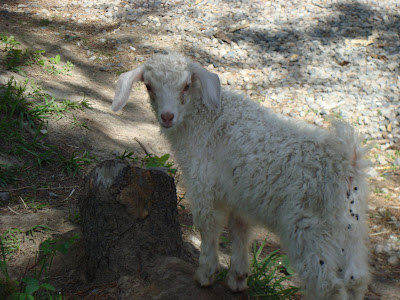I've always been curious about what it would be like to live on a farm. Immersion in life with the Dalziels at Joybilee farms definitely satisfied that curiosity - one of the things that struck me right away was how different the rhythm of the day was. We're used to regimented schedules, having to show up for work etc. at certain times, having a rough idea of what our days and weeks will hold. On the farm, no one wore watches. The day's activities were dictated by nature, the animal's needs, things that would occur unexpectedly such as a customer or sick animal.

The flock going out to pasture
I slept in a small trailer behind the house, and would wake up at 5 or 6 am to sunlight and the sounds of roosters and chickens (usually the cold would keep me from getting up for a while yet!). I felt a bit like Chris in the Morning from Northern Exposure, and it was kind of fun! Robin would usually be up early doing chores. We'd convene for breakfast at 7:30, and then start our chores at 8. Chores were things that were done every day, usually at 8 am and pm. These were the things that had to be done, such as feeding the animals and letting them out to pasture. My main chore was taking care of 30 Angora rabbits. After chores, we would do whatever work needed to be done around the farm: if it wasn't raining, usually this involved weeding and mulching the gardens, clearing the orchard, or shovelling manure out of the barn. I loved the meditative, physical nature of the work, especially being down in the gardens.

Topaz, an Angora rabbit we brought in to be groomed
Other times, the work would involve fiber-related stuff, like plucking the angora rabbits, skirting and sorting fleeces, or getting ready for workshops. In the afternoon, when it would be too hot to work outdoors, we would do lighter indoor work, or go into town for errands. After dinner, sometimes we would do some more work, or do something like go for a walk on the
acreage. By the time everyone finished up evening chores it would be 9pm or later, and we'd meet up in the living room for an hour of rest before bed (often this involved watching documentaries while spinning). Some days were lighter than others, and often we'd all be exhausted at the end of the day.

A kid Angora who got separated from his mom
I learned pretty quickly that you can't be type A or a perfectionist with farm work, or you would never rest (you can't pull
every weed out of the garden or pick up
all of those little twigs!) . Things can also change at the drop of a hat, so you have to be pretty flexible as well. It was neat to see how the
Dalziels had figured out what worked and what didn't, and that they are still learning daily.

Amaretto and her brand-new cria Latte
One of my favorite things at the farm was spending time with Chris. She was so knowledgeable, and perpetually cheerful despite whatever calamity may have been happening. She understood what my goals in being there were (to learn how to spin, and to see if having a hobby farm would be something I'm interested in in the future), and catered to that. She was a total task master when it came to getting my spinning done, and I loved it!

Donder and Gelato
By the end of my time there, I had a solid sense of how wool processing works from the ground up. The
Dalziels have a flock of over 100 sheep and goats. Their sheep are mostly Romney and
Rambouillet. They have several Angora goats (which produce mohair), as well as
Sanaan dairy goats. They also had seven guard llamas, 8 dogs, over 50 chickens, ducks, two turkeys, the Angora rabbits, and a few cats. That's a big brood for one family to take care of, on top of trying to garden and run a business!

Llamas sauntering by: Cappuccino, Latte, Amaretto, Mocha, Saline, and Espresso
I absolutely loved the animals, but had a special fond spot for the dogs, especially my good buddy
Gelato.
Gelato is a 1 year old
Maremma (livestock guardian dog), who at his less-than-full size still outweighs me. These dogs will sacrifice their life to fend off cougars, bears, and coyotes, but have only gallons of goofy love for humans! He and
Donder, a Great
Pyrenees, had five puppies. I would find myself hanging out with
Gelato, only to be surrounded by six other affectionate dogs seconds later. It was awesome.

A happy moment of dog love with Donder, Gelato, and brood!
The goats and sheep were more aloof, and aside from the three "bottle babies" who were used to being fed by humans didn't really care to interact with me all that much. The llamas on the other hand, were very curious and expressive, and would saunter right up to say hi. One of the llamas, Amaretto, had a baby
cria while I was there. It was so cool to see her interact with it in such a loving way right after it was born!

The flock coming up from pasture
I have to wrap this up, as I'm leaving for home tomorrow and still have a lot to do. I will get to the fiber stuff soon, I promise!!































